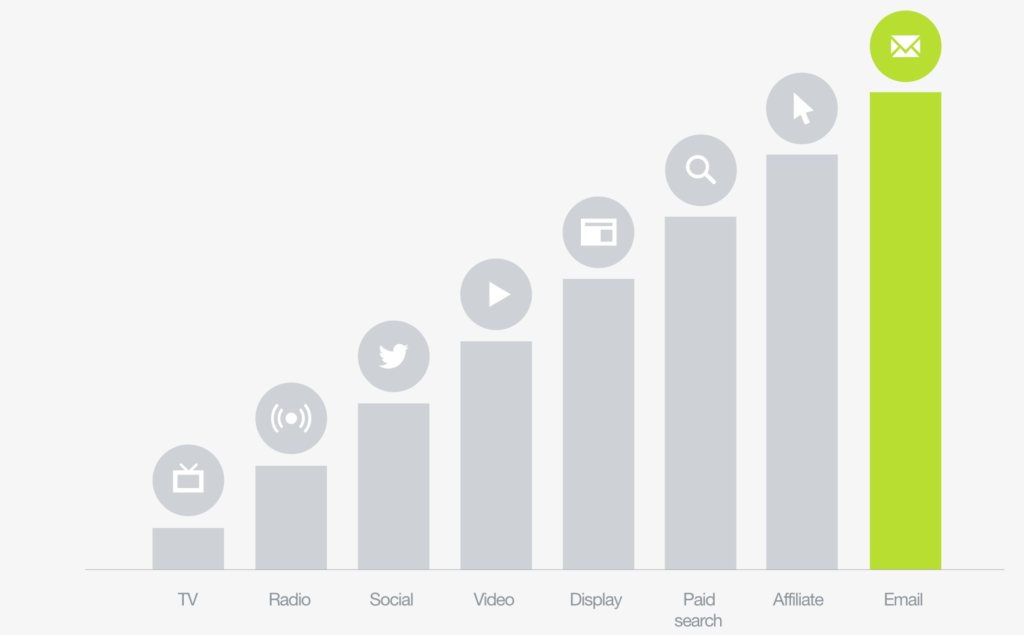Email is the OG digital marketing tool.
While it might seem basic and a little bit boring, email is actually the most advanced medium of communication between marketers and their ideal customers. It’s ubiquitous, low cost, reliable, and provides high-impact benefits.
Customers have become highly accustomed to using email when communicating with a brand, and email performance is a critical factor in the success of digital marketing campaigns.
Let’s take a closer look at why you should pay attention to the most measurable, automatable, and scalable asset in the digital marketer’s toolkit.
1. You’ll get high ROI
According to Campaign Monitor, email marketing generates $38 for every $1 spent, which computes to a 3,700% ROI. That statistic alone offers an incentive for brands to take a closer look at their email marketing strategy and to maximize return.
In fact, for the past ten years in a row, email has been the channel that produces the highest ROI for marketers. A surprising stat: Email is 40 times more effective at acquiring new customers than Facebook or Twitter.

Source: Campaign Monitor
2. You can engage prospects throughout the customer lifecycle
One of the greatest benefits of email is the fact that it suits every stage of the customer lifecycle.
Stage 1: New Subscribers
At this stage, email is used to welcome new prospects at the beginning of the purchase journey who have filled out a form on your website. These early-stage emails should provide more information about your product or service. and establish brand awareness by inviting customers to connect through a meeting, webinar, free trial, or demo.
Stage 2: New Paying Customers
You’ve just closed the deal and brought a new customer on board. At the start of this stage, email marketing strategies help customers make a payment or commit by e-signing a contract. From then on, brands must convert first-time customers into repeat buyers.
Building trust is essential to convincing customers to buy more than once. Email can also be used to familiarize customers with your product and services by sharing content such as blogs or case studies.
Stage 3: Active Customers and Subscribers
These are loyal customers who interact with your brand frequently and make repeat purchases. Thoughtful email marketing can encourage this high-value set of customers through loyalty offers, bonuses, limited time offers, and exclusive invitations.
Stage 4: Dormant Subscribers, Unsubscribers, and Churn
In stage four, email can be used to determine which customers are no longer interested in your brand or doing business with it. First, they typically stop opening your emails, which signals that it’s time to attempt to re-engage them. Once they have unsubscribed or churned through your email marketing funnel it is much more difficult to revive them.
3. You’ll gain essential insights through simple metrics
Email metrics offer a crucial window into how your audience engages with your brand and can guide your email strategy.
Open Rate
The email open rate tells you what percentage of recipients opened a specific email out of the total number sent. A study by MailChimp found that the average email open rate across industries is 21.33%.
Let’s say, for example, that you ran a welcome campaign for new customers and got a 50% open rate. That means you have a higher-than-average engaged cohort of new customers. This information can help you make strategic decisions about how you should sell to this segment and. indicates how well the email subject line and body copy captured your audience.
Bounce Rate
This is the percentage of emails that didn’t reach the recipient’s mailbox. There are two types of bounces:
Hard bounces don’t make it into inboxes for permanent reasons, such as incorrect addresses, issues with the domain address, or problems with the email server. The above-mentioned study also found that the cross-industry average for hard bounces is 0.40%.
Soft bounces are caused by temporary problems such as a full inbox or an email file that is too large. The cross-industry average for hard bounces is 0.58%.
Bounce rates are a strong indicator of the quality of email lists and sources. Bad bounce rates can land your domain on an email blacklist. It’s important to manage and clean your email list every time you send out a new message.
Click-through Rate (CTR)
CTR measures how many people clicked on a link, call to action (CTA), or image within an email. CTR provides an indication of how well the content of the email connected with the audience. The cross industry average for average CTR is 2.62%.
Say you were running a nurture campaign to educate your audience about an offering. If the campaign had an underperforming CTR of 1%, you might try an alternative design, different content, or a revised CTA.
Conversion Rate
This is the gold standard metric for email marketing performance. Conversion rate is the percentage of recipients who complete a desired action after reading an email. It indicates the ROI and ultimately determines the success of your email marketing strategy.
A study by Barilliance, an eCommerce personalization suite, found that in 2020, the average email conversion rate based on click-through across the surveyed industries was 15.11%.
If you ran a referral campaign via email that resulted in a below-average conversion rate, you might adjust how you present your offer to customers or reconsider the offer itself.
Unsubscribe Rate
High unsubscribe rates act as a red flag in email marketing. This metric provides an indication of how many recipients no longer wish to engage. The industry average for unsubscribe rates is 0.17%, but anything below 2% is considered normal.
Higher unsubscribe rates should set off warning bells in your mind. Typically they are an indication that you should try a new tactic and change the content of your email campaign.
A Marketing Tool with Staying Power
Marketing technology is evolving at a dizzying pace, but the good news is that the humble email is nimble enough to adapt, too. You can integrate email into your social media strategy, automate it to run at specific times in the customer life cycle, and use it to collect important data. It doesn’t cost much, and it can be used by small businesses and enterprise companies alike. Give it a try and see how it transforms your revenue engine.
This article was reposted from our subsidiary site NeverBounce.


